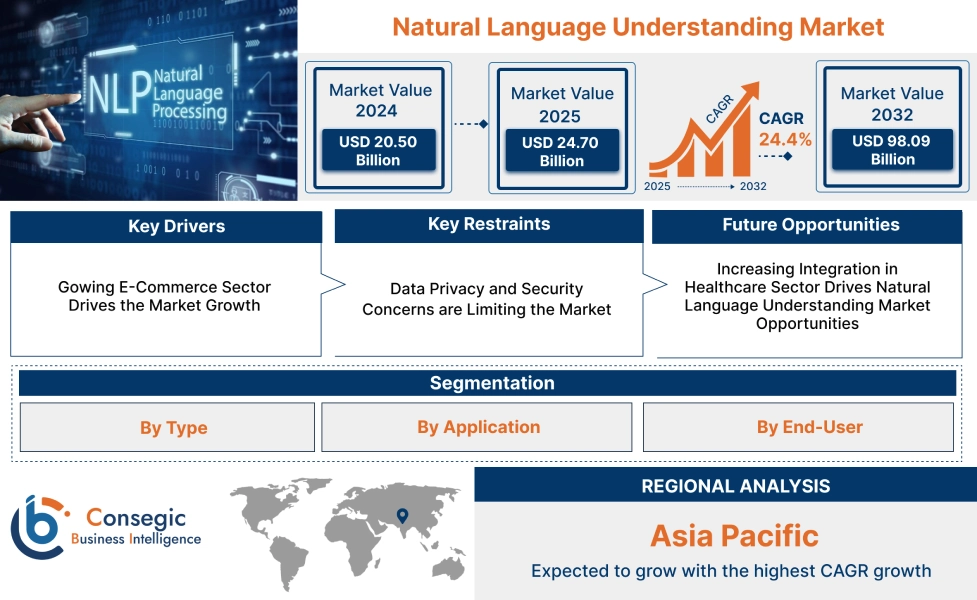Natural Language Understanding Market Size:
Natural Language Understanding Market is estimated to reach over USD 98.09 Billion by 2032 from a value of USD 20.50 Billion in 2024 and is projected to grow by USD 24.70 Billion in 2025, growing at a CAGR of 24.4% from 2025 to 2032.
Natural Language Understanding Market Scope & Overview:
Natural language understanding is a subfield of artificial intelligence that focuses on enabling machines to comprehend and interpret human language with a level of understanding similar to a human. The primary objective is to extract the meaning, intent, and context behind spoken or written words. The key applications include chatbots & virtual assistants, customer experience management, text and sentiment analysis, and others. Further, key trends driving the market include rapid advancements in AI and machine learning, growing demand for conversational AI applications like chatbots and virtual assistants and the rise of unstructured data from various sources.
How is AI Impacting the Natural Language Understanding Market?
AI is massively accelerating the natural language understanding sector by leveraging advanced machine learning and deep learning models. This allows for a deeper, more accurate interpretation of human language, including context, intent, and sentiment. This enhanced capability is fueling the growth of AI-powered applications like conversational chatbots, intelligent virtual assistants, and sophisticated data investigation tools across a range of industries, including healthcare, finance, and e-commerce. As a result, the market is experiencing significant growth and innovation, with a strong focus on creating more intuitive and human-like interactions.
Natural Language Understanding Market Dynamics - (DRO) :
Key Drivers:
Gowing E-Commerce Sector Drives the Market Growth
The burgeoning e-commerce sector is a powerful catalyst for the NLU market. With rising global online sales, companies are faced with a massive influx of unstructured data from customer reviews, queries, and social media. The technology is essential for making sense of this data, allowing e-commerce businesses to understand customer sentiment, track purchasing patterns, and personalize the shopping experience. Furthermore, the technology is behind the intelligent chatbots and virtual assistants that provide 24/7 customer support, and the sophisticated search bars that accurately interpret natural language, even with typos or synonyms. By enhancing the customer journey and providing businesses with actionable insights, e-commerce is directly fueling the demand for advanced solutions.
- For instance, according to International Trade Administration, Global B2C e-commerce revenue reached USD 4.19 trillion in 2024 and is expected to grow to USD 5.5 trillion by 2027.
Thus, growing online sales driven by convenience and penetration of high speed internet contributes significantly to the natural language understanding market size.
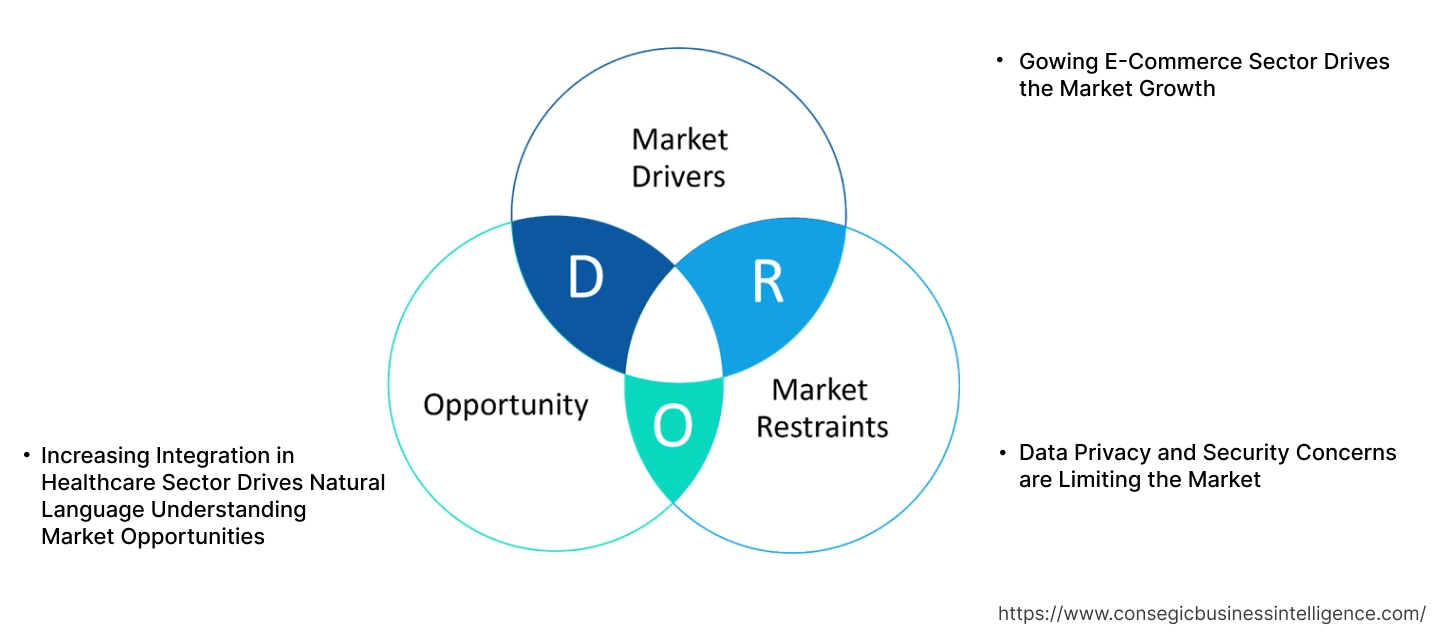
Key Restraints :
Data Privacy and Security Concerns are Limiting the Market
Data privacy and security concerns are a significant and growing restraint on the Natural Language Understanding market. As the systems become more sophisticated and embedded in daily life, they handle increasingly sensitive data, from customer support inquiries containing personal details to medical records and financial information. This collection and processing of data, if not managed correctly, exposes organizations to a higher risk of data breaches, which can lead to severe financial penalties, legal liabilities, and a significant loss of consumer trust. The complex landscape of global regulations, such as GDPR and CCPA, further complicates matters by imposing strict requirements on data collection, storage, and use. The cost and effort of ensuring compliance with these regulations can be a major barrier, particularly for smaller businesses.
Future Opportunities :
Increasing Integration in Healthcare Sector Drives Natural Language Understanding Market Opportunities
The healthcare sector presents immense opportunities for the market due to the vast amounts of unstructured data it generates, from patient notes and medical reports to clinical trial data. The technology is crucial for analyzing this complex, domain-specific language to extract valuable insights. For instance, these systems can automatically process clinical documentation, reducing the administrative burden on healthcare professionals and minimizing errors. They can also aid in clinical decision support by identifying patterns in patient data and medical literature to help with diagnoses and treatment recommendations. Furthermore, the technology enables more effective patient engagement through conversational AI, offering personalized support and scheduling services, which ultimately improves the quality and accessibility of care.
- For instance, in April 2024, Kakao Healthcare announced a collaboration with Google for improving its cloud-based data platform. Moreover, Kakao Healthcare also announced that it will use the latest technologies from Google, including language learning model-based named entity recognition tech, which can extract information from text.
Thus, need for analyzing and extracting valuable insights from healthcare data in turn drives natural language understanding market opportunities.
Natural Language Understanding Market Segmental Analysis :
By Type:
Based on the type, the market is segmented into statistical, rule-based, and hybrid.
Trends in the Type:
- The simplicity of rule-based systems makes them a perfect fit for low-code and no-code platforms which in turn drives the natural language understanding market trends.
- Increasing use of rule-based systems for applications that require high precision, and deterministic outcomes drive natural language understanding market size.
Statistical accounted for the largest revenue share of 58.45% in the year 2024.
- Increasing adoption of transformer-based models such as BERT and GPT drives the natural language understanding market share.
- Further, there is an increasing focus on integration of statistical NLU with other data types such as images, audio, and video.
- Furthermore, need for highly accurate and relevant NLU systems for particular industries, such as legal, healthcare, and finance drives the natural language understanding market trends.
- Thus, focus on multimodality, rise of transformer-based models, and domain-specific model are driving the market.
Hybrid is anticipated to register the fastest CAGR during the forecast period.
- Hybrid models are increasingly integrating external knowledge bases, such as knowledge graphs or structured databases in turn driving the market.
- Further, hybrid systems are increasingly built around intent-driven architecture which in turn propels the natural language understanding market expansion.
- Therefore, based on natural language understanding market analysis, intent-driven architecture and external knowledge integration are anticipated to boost the market during the forecast period.
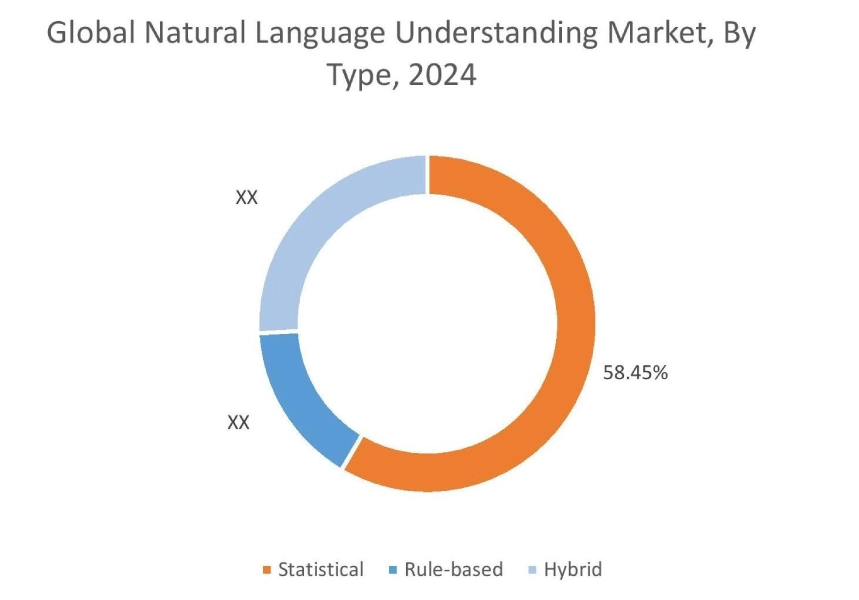
By Application:
Based on the application, the market is segmented into chatbots & virtual assistants, customer experience management, text analysis, sentiment analysis, machine translation, and others.
Trends in the Application:
- There's a growing integration of generative AIas it's revolutionizing text analysis by enabling not just the understanding of text, but the creation of new content and insights which in turn drives the natural language understanding market expansion.
- Businesses are using NLU for real-time sentiment analysis on social media and other public platforms to monitor brands which subsequently propels the natural language understanding market demand.
Chatbots & virtual assistants accounted for the largest revenue share in the year 2024.
- Chatbots are now using these technologies to remember past interactions, understand user preferences, and tailor their responses and recommendations in real-time.
- Further, chatbots are evolving into multimodal assistants that can process and respond to text, voice, and even images or videos which in turn drives the natural language understanding market growth.
- Furthermore, the next generation of chatbots are becoming more autonomous which in turn drives natural language understanding market growth.
- For instance, according to IBEF, India's retail market is projected to expand significantly, reaching USD 1.6 trillion by 2026 with a robust annual growth rate of 10%. The growing retail sector is expected to drive the market during forecast period.
- Thus, hyper-personalization, multimodal AI, and autonomous AI agents are driving the market.
Customer experience management is anticipated to register the fastest CAGR during the forecast period.
- Increasing use of predictive analytics for analyzing sentiment and keywords in customer feedback which in turn drives the natural language understanding market share.
- Further, a key trend is the fusion of NLU with VoC data from various channels including social media, reviews, and support tickets which propel the market growth.
- Furthermore, hyper-personalization and real-time sentiment monitoring are driving the market.
- Therefore, aforementioned trends are anticipated to boost the market during the forecast period.
By End User:
Based on the end user, the market is segmented into BFSI, retail & E-commerce, IT & telecommunication, healthcare & life sciences, media & entertainment, and others.
Trends in the End User:
- Increasing need for analyzing an individual's financial data and their stated goals to provide personalized financial advice which in turn drives the natural language understanding market.
- Increasing adoption of the solution by retailers for automatically analyzing thousands of product reviews and customer feedback in turn driving the market.
Retail & E-commerce accounted for the largest revenue share in the year 2024.
- Increasing integration into chatbots and voice assistants to facilitate "conversational commerce" is driving the market.
- Further, there is a growing need for highly accurate and personalized product recommendations that drive sales and improve customer satisfaction.
- Furthermore, there is an increasing need for NLU in supply chain and inventory management which in turn drives natural language understanding industry.
- For instance, in May 2024, Oracleannounced the availability of OCI (Oracle Cloud Infrastructure) Language 4.0. Moreover, OCI Language 4.0 introduced three new capabilities that offer high-quality, affordable text analytics services for its customers. Additionally, OCI Language also performs sophisticated text analysis at scale.
- Thus, as per natural language understanding market analysis, conversational commerce and hyper-personalized product recommendations are driving the market.
Healthcare & life sciences is anticipated to register the fastest CAGR during the forecast period.
- Increasing adoption in healthcare to analyze a massive volume of biomedical literature, research papers, and patents to identify new drug targets, understand disease mechanisms, and find potential drug candidates.
- Further, growing adoption for integrating and analyzing complex patient data from various sources, including EHRs, genomics reports, and patient-reported outcomes.
- Furthermore, increasing adoption in clinical decision support and patient engagement, drives the natural language understanding market demand.
- Therefore, aforementioned trends are anticipated to boost the market during the forecast period.
Regional Analysis:
The regions covered are North America, Europe, Asia Pacific, Middle East and Africa, and Latin America.
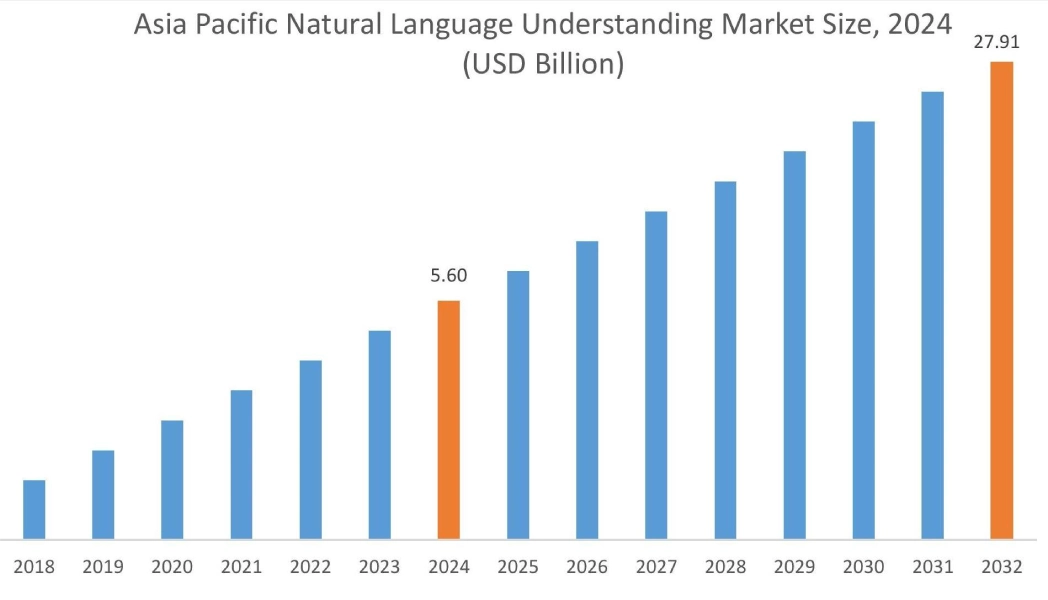
Asia Pacific region was valued at USD 5.60 Billion in 2024. Moreover, it is projected to grow by USD 6.77 Billion in 2025 and reach over USD 27.91 Billion by 2032. Out of this, China accounted for the maximum revenue share of 34.48%. The market for Natural Language Understanding is mainly driven by exponential increase in the digital population and the widespread adoption of smartphones, which generates vast amounts of unstructured data. Additionally, growing e-commerce and retail industry is further driving the market.
- For instance, according to International Trade Administration, between 2023 and 2027, China is projected to have major rise in retail e-commerce sector, boasting a CAGR of 12.17%.
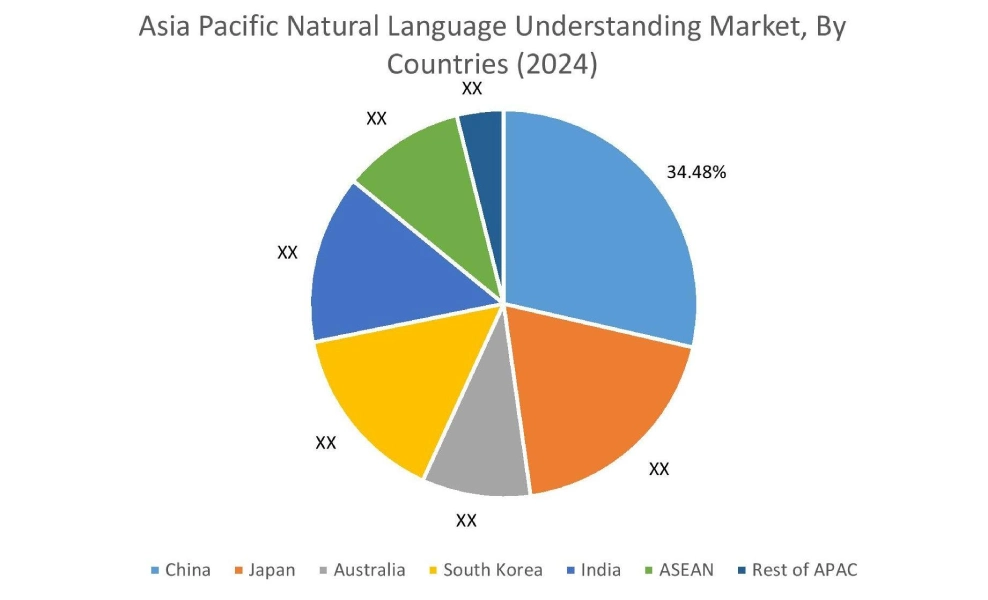
North America is estimated to reach over USD 33.67 Billion by 2032 from a value of USD 7.00 Billion in 2024 and is projected to grow by USD 8.43 Billion in 2025. The North American market is primarily driven by advanced technological infrastructure and the presence of major tech giants who are pioneers in AI research and development.
- For instance, in May 2024, OpenAI introduced GPT-4o, which is a large language model that is developed for enhancing ChatGPT by improving real-time spoken conversations, along with facilitating multi-modal interactions such as text, voice, and images, and memory capabilities for enhanced user experience.
The regional analysis depicts that strict data privacy regulations and high demand for multilingual solutions to cater to diverse populations in Europe are driving the market. Additionally, the market in the Middle East and African region is driven by the rapid digital transformation across industries and the increasing demand for AI-powered customer support solutions. Further, rapid digital transformation initiatives and a young, tech-savvy population are paving the way for the progress of market trends in Latin America region.
Top Key Players & Market Share Insights:
The global Natural Language Understanding market is highly competitive with major players providing solutions to the national and international markets. Key players are adopting several strategies in research and development (R&D), product innovation, and end-user launches to hold a strong position in the natural language understanding industry. Key players in the global Natural Language Understanding market include-
- Microsoft Corporation(US)
- Oracle (US)
- NVIDIA Corporation (US)
- OpenAI (US)
- SAP SE (Germany)
- IBM(US)
- Google LLC (US)
- com, Inc. (US)
- Meta (US)
- Salesforce, Inc. (US)
Recent Industry Developments :
Partnership:
In May 2024, IBM announced a partnership with Salesforce for integrating WatsonX AI and Data Platform capabilities from IBM with the Salesforce Einstein 1 Platform. This partnership aims at improving customer options and flexibility in AI as well as data deployment. Moreover, the partnership also enables flexibility in large language models, bi-directional data integration, pre-built actions and prompts for CRM solutions, among others.
Natural Language Understanding Market Report Insights :
| Report Attributes | Report Details |
| Study Timeline | 2019-2032 |
| Market Size in 2032 | USD 98.09 Billion |
| CAGR (2025-2032) | 24.4% |
| By Type |
|
| By Application |
|
| By End User |
|
| By Region |
|
| Key Players |
|
| North America | U.S. Canada Mexico |
| Europe | U.K. Germany France Spain Italy Russia Benelux Rest of Europe |
| APAC | China South Korea Japan India Australia ASEAN Rest of Asia-Pacific |
| Middle East and Africa | GCC Turkey South Africa Rest of MEA |
| LATAM | Brazil Argentina Chile Rest of LATAM |
| Report Coverage |
|
Key Questions Answered in the Report
How big is the natural language understanding market? +
The natural language understanding market is estimated to reach over USD 98.09 Billion by 2032 from a value of USD 20.50 Billion in 2024 and is projected to grow by USD 24.70 Billion in 2025, growing at a CAGR of 24.4% from 2025 to 2032.
What specific segmentation details are covered in the natural language understanding report? +
The natural language understanding report includes specific segmentation details for type, application, end user, and regions.
Which is the fastest segment anticipated to impact the market growth? +
In the natural language understanding market, customer experience management is the fastest-growing segment during the forecast period.
Who are the major players in the natural language understanding market? +
The key participants in the natural language understanding market are Microsoft Corporation (US), IBM (US), Google LLC (US), Amazon.com, Inc. (US), Meta (US), Salesforce, Inc. (US), Oracle (US), NVIDIA Corporation (US), OpenAI (US), SAP SE (Germany) and others.
What are the key trends in the natural language understanding market? +
The natural language understanding market is being shaped by several key trends including rapid advancements in AI and machine learning, growing demand for conversational AI applications like chatbots and virtual assistants and the rise of unstructured data from various sources.
